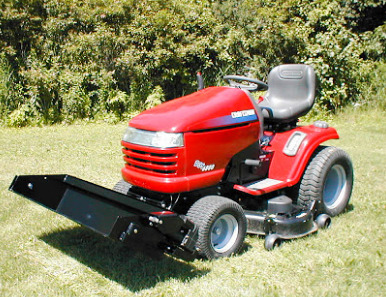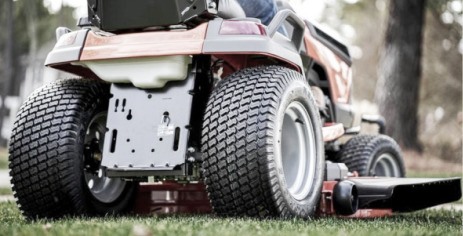________________________________________________________________________________________
Craftsman DGT6000 Troubleshooting
 The
Craftsman DGT6000 is a 2-wheel drive garden tractor. This model was manufactured
between 2004 and 2005. The Craftsman DGT 6000 driveline consists of a 44 cu.in
(725 cc) Kohler Command CV740 4-cycle V-twin cylinder OHV air-cooled gasoline
engine and Hydro-Gear 311-3500 belt-driven hydrostatic transmission, or gear
transmission with 6 forward and 2 revers gears.
The
Craftsman DGT6000 is a 2-wheel drive garden tractor. This model was manufactured
between 2004 and 2005. The Craftsman DGT 6000 driveline consists of a 44 cu.in
(725 cc) Kohler Command CV740 4-cycle V-twin cylinder OHV air-cooled gasoline
engine and Hydro-Gear 311-3500 belt-driven hydrostatic transmission, or gear
transmission with 6 forward and 2 revers gears.
The engine has a cylinder bore of 3.27" (83 mm), piston stroke of 2.64"
(67 mm), and rated power of 27 hp (20.1 kW). The fuel system has a fixed
main jet carburetor and pulse fuel pump.
Max. forward speed - 5.8 mph (9.3 km/h), max. reverse speed - 2.1 mph
(3.4 km/h). The Craftsman DGT6000 tractor was equipped with 16x7.50-8
front tires and 24x12.0-12 rear tires. The tractor can be fitted with
the following attachments: a 48" or 54" mid-mount 3-blade mower decks
with cutting height of 1.5-4.5 inches (37-115 mm) and mechanical lift
system.
| Engine Troubleshooting |
| Engine starts hard or doesn't start |
| No fuel in fuel tank - Fill it up |
| Improper fuel grade - Use correct fuel grade |
| Fuel system clogged - Repair or replace |
| Spark plug wire connection are damaged - Inspect spark plug wiring connection, change or repair |
| Defective spark plug - Change spark plug as required |
| Clogged fuel filter - Fuel filter needs to be replaced |
| Brake pedal not pushed down - Push the brake pedal down |
| Carburetor malfunction - Check and repair as required |
| Weak cylinder compression - Inspect cylinder block and change worn parts |
| Throttle cable is adjusted incorrectly or damaged - Adjust properly or change the cable |
| Cooling fins are clogged - Need to wash or clean |
| Ignition system failure - Inspect ignition system and change faulty parts |
| Defective or stuck choke cable - Clean or replace the cable |
| Dirty air filter element - Service or change air filter |
| Fuel pump is clogged or faulty - Clean or replace fuel pump |
| Engine starts and stalls immediately |
| Spark plug is damaged - Install new spark plug |
| Carburetor is clogged or defective - Clean or replace carburetor |
| Ignition coil is damaged - Install a new ignition coil |
| Valve springs are bad or broken - Change valve springs |
| Valves sticking - Clean the valves |
| Not enough engine oil - Check and refill engine oil |
| Engine is overloaded - Reduce the load |
| Cooling fins are plugged - Need to wash or clean |
| Too lean carburetor mixture - Adjust carburetor correctly |
| Wrong ignition timing - Adjust ignition timing as required |
| Wrong valve setting - Valves needs to be adjusted properly |
| Low octane fuel - Use proper fuel |
| Engine overloaded - Reduce the load |
| Lack of engine oil - Fill up the engine oil |
| Incorrect low idle setting - Correct idle settings |
| Clogged or defective fuel pump - Check fuel pump and change if required |
| Crankshaft or main bearings are worn out - Change or repair worn components |
| Excessive valve clearance - Adjustment procedure required |
| Piston rings or cylinder bore are damaged - Change defective components |
| Improperly or clogged carburetor - Adjust the carburetor properly or clean it |
| Clogged air filter - Clean or replace air filter |
| Dirty or defective fuel pump - Clean or replace fuel pump |
| Ignition failure - Inspect ignition system and change failed components |
| Cylinder head gasket is defective - Replace the head gasket |
| Valves are stuck or burned - Service or change valves |
| Push rod is worn or damaged - Install a new push rod |
| Cylinder block components are damaged - Defective components need to be replaced |
| Engine using too much gasoline |
| Insufficient throttle opening - Adjust or replace throttle cable |
| Incorrect carburetor main jet adjustment - Adjust main jet as required |
| Spark plug is loose or defective - Tighten or replace spark plug |
| Valves are worn, burned or stuck - Service or replace valves |
| Worn sleeve, rings, or piston - Change defective components |
| Valve clearance is incorrect - Adjustment procedure required |
| Excessive oil consumption |
| Worn seals or gaskets - Install new components |
| Valve stems and guides are worn - Valves must be replaced |
| Piston rings are stuck or broken - Change piston rings |
| Scuffed piston or cylinder liner - Inspect liner and piston, replace as necessary |
| Breather pipe or hose is plugged - Clean or replace |
| Transmission Troubleshooting |
| Hard to shift gears |
| Gear shift linkage is corroded or worn - Lubricate or replace shift linkage |
| Shift forks are worn or bent - Replace defective shift forks |
| Worn gear shift mechanism - Replace worn components |
| Transmission oil level is low - Fill the transmission housing to proper oil level |
| Transmission oil is contaminated - Fill up with fresh transmission oil |
| Worn gears or bearings - Change faulty parts |
| Transmission jumping out of gear |
| Damaged or incorrectly installed gear shift lever - Install the lever correctly or replace it |
| Gears are worn or damaged - Replace gears |
| Faulty shift forks or shift rods - Replace damaged forks or rods |
| Drive belt/shaft is defective or improperly adjusted - Change belt/shaft or adjust it |
| Brake/clutch is incorrectly adjusted or faulty - Install a new brake/clutch or adjust it |
| Worn or faulty drive pulley - Replace pulley |
| Hydrostatic Transmission Troubleshooting |
| HST transmission makes noise |
| Speed control pedal linkage is bent or not adjusted - Adjust or repair linkage |
| Transmission overload - Reduce loading |
| Transmission fluid is dirty or fluid level is too low - Add fluid to the correct level or fill the HST with fresh fluid |
| Worn or defective transmission components - Check hydrostatic transmission components for defect or damage and change if necessary |
| Stuck or damaged gshift linkage - Replace or repair the linkage |
| Seized or worn hydrostatic pump - Replace or repair pump |
| Transmission shift control components are defective or misadjusted - Adjust properly or change |
| Low oil level - Fill the transmission housing with oil |
| Drive sheave is damaged or worn - Replace sheave |
| Shifting linkage is misadjusted or broken - Adjust properly or change linkage |
| Speed control linkage is worn or unadjusted - Adjust or repair linkage |
| Transmission gaskets or seals are worn - Replace gaskets or seals |
| Final drive shaft leaks - Shaft seals need to be changed |
| Cracked transmission housing - Replace damage housing or transmission assembly |
| Mower Deck Troubleshooting |
| Mower vibration is excessive |
| Mower deck drive pulley is worn or dirty - Replace or clean pulley |
| Damaged or loose drive belt - Adjust belt tension or change the belt |
| Mower blades are warped or not balanced - Balance or change blades |
| Blade bolts are not tightened well - Tighten it fast |
| Discharge chute regular clogging |
| High mowing speed - Select a slower speed |
| Long grass - Need to set low cutting height |
| Engine is running at too low speed - Adjust carburetor to higher rpm |
| Mower deck set to low cutting - Adjust mower to higher cutting height |
| Drive belt installation is not correct - Install drive belt as required |
| Grass patches are not cut |
| Deck clogged with grass clippings - Clean out the mower deck |
| Blades are not sharp - Sharpen the blades |
| Worn or damaged blades - Change the blades |
| High ground speed - Use a slower speed |
| Mower cuts too low - Use correct cutting height |
| Grass bag is overfilled - Clean grass bag |
| Bumpy or unleveled lawn - Lawn needs to be leveled |
| Low cutting height - Need to set high cutting height |
| High ground speed - Use a lower speed |
| Improper mower deck level - Adjust the level of mower deck correctly |
| Bent or worn blades - Blades need to be replaced |
| Low tire pressure - Check and inflate the tires |
| Mower deck to cut unevenly |
| Incorrect tire pressure - Inflate tires correctly |
| Deck level is not correct - Adjust mower deck level properly |
| Not sharp blades - Need to sharpen the blades |
| Worn or bent blades - Replace the blades |
| Discharge area is clogged - Inspect and clean cutting deck |
| Broken mower deck housing - Replace or rebuild mower deck |
| Bent or loose mower spindle - Repair or replace the spindle |
| Electrical Troubleshooting |
| Battery will not charge |
| Wiring connections are corroded or loose - Service or tighten cable connections |
| Defective battery terminal clamps - Change terminal clamps |
| Worn-out battery - Replace the battery |
| Battery power is low - Battery is drained, charge it |
| Battery is draining quickly - Service or replace the battery |
| Terminals are faulty or battery cables are disconnected - Check cables and service or change terminals |
| Battery is low or faulty - Recharge or replace battery |
| Battery cables are disconnected or incorrectly connected - Check cables and connect as needed |
| Low battery power - Low battery charging, charge as required |
| Faulty or incorrectly gapped spark plug - Clean, gap or change spark plug |
| Starter motor or solenoid is defective - Change solenoid or repair starter |
________________________________________________________________________________________
________________________________________________________________________________________
| Lawn and Garden Tractors Technical Specs |
 The
Craftsman DGT6000 is a 2-wheel drive garden tractor. This model was manufactured
between 2004 and 2005. The Craftsman DGT 6000 driveline consists of a 44 cu.in
(725 cc) Kohler Command CV740 4-cycle V-twin cylinder OHV air-cooled gasoline
engine and Hydro-Gear 311-3500 belt-driven hydrostatic transmission, or gear
transmission with 6 forward and 2 revers gears.
The
Craftsman DGT6000 is a 2-wheel drive garden tractor. This model was manufactured
between 2004 and 2005. The Craftsman DGT 6000 driveline consists of a 44 cu.in
(725 cc) Kohler Command CV740 4-cycle V-twin cylinder OHV air-cooled gasoline
engine and Hydro-Gear 311-3500 belt-driven hydrostatic transmission, or gear
transmission with 6 forward and 2 revers gears.